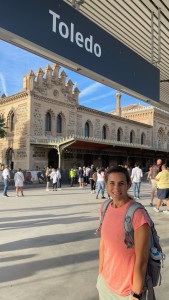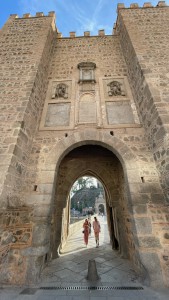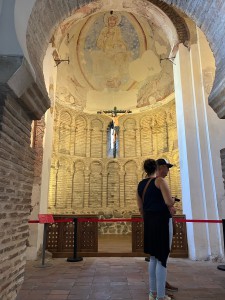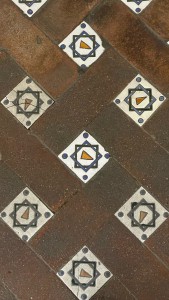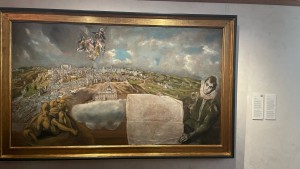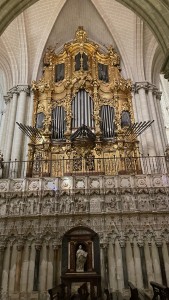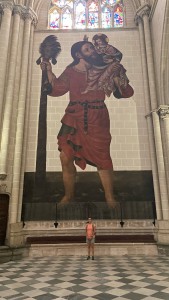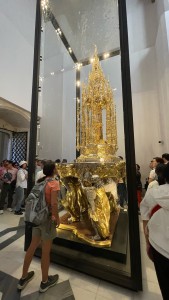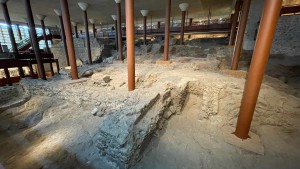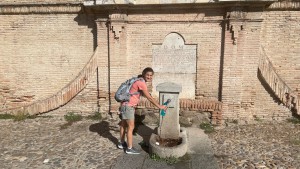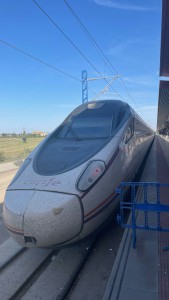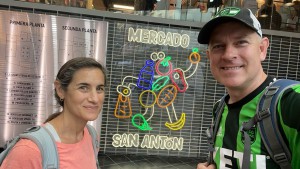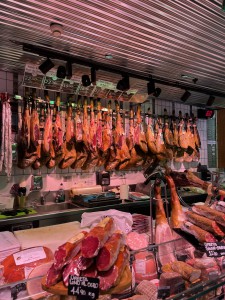In case we hadn’t walked enough the day before, Tuesday was when we were finally able to get train tickets to Toledo, and basically walk the city for the day. The start of the train ride there was a very interesting. It reminded me a bit of Penn Station in NY. Everyone mills around until the departure track gets posted on a board, at which point everyone rushes to the track. We were standing around, waiting and waiting, no track for our train yet, and we notice that the earlier train to Toledo was still up on the board. Maybe about 15 mins late, a track gets posted, the same track for both our train and the earlier train. We stand in line to get our tickets scanned and head out to the train to find our seats. We had purchased reserved seats. It was not obvious which car was which, so we were walking along the train looking, and one of the train station workers basically tells us just to hurry up and get on the train and find any seat. They had put all the people from both our train and the earlier one on a single train, it was pretty much find any seat you could. Once boarded, we then waited another 20 mins before the train left. The conductors didn’t speak much English, and the best that we could understand was there was something wrong with the track that was being fixed. Either way, once the train departed, the ride was a fast 30 mins and uneventful.
The Toledo train station was gorgeous. It was rebuilt in 1919, to match the architecture of the city. While relatively new for Spanish history, it reminded me of some of the ‘old’ train stations in the United States.
Toledo has a historic old city surrounded by rivers on three sides. It’s a UNESCO World Heritage Site, known throughout history as a prosperous city and controlled at different times by Jews, Muslims, and Christians. There was a lot we wanted to see in one day. To get from the train station to the old city, we crossed the Puente de Alcantara, a historic bridge with amazing views of the Alcazar Fortress. Of course, we had to stop for some breakfast before the long day ahead. Similar to Madrid, small cafes are every other shop, so we popped into one that looked good. Want to guess what I had for breakfast? Avocado toast with smoked salmon, goat cheese, and sprouts. I don’t remember what Ryan had, probably some toast with jamon.
Toledo, as we quickly learned, is an incredibly hilly city, with lots of up and down, and very narrow streets shared by cars and pedestrians, even narrower than the streets we were getting used to in Madrid. Texas sized trucks, maybe even SUVs, would never make it down those roads.
First stop was the Mezquita del Cristo de la Luz, a mosque built in 999. At the entrance, one could see an old Roman road and the sewer system below it. Rather than point towards Mecca, this mosque faces towards Cordoba because at that time it would built to face the caliphate of Cordoba. The apse was added to the Mosque in the 1100s when Christians conquered the city.
Next we walked to the Monasterio de San Juan de los Reyes, where I was very excited to find a public restroom in decent shape. Public restrooms have been very hard to come by in Madrid. Each food establishment has a restroom, with usually one, maybe two stalls, regardless on the size of the place. But otherwise, it is very challenging to find a bathroom that is in decent working order and doesn’t have a huge line, because there are very few stalls. One would think with all the wine that gets consumed, people would need to use the bathroom more.
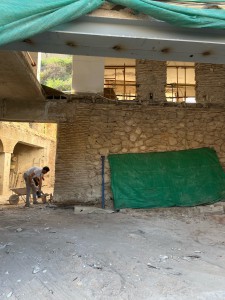
‘New’ construction we passed on the walk. We found it fascinating how buildings are rebuilt using the same very old structures
I don’t remember a lot about the monastery itself. We met a nice gentleman who talked at us for a while. He was originally from Bulgaria, lived in West Orange, NJ, had a son who just moved to Austin, and a daughter who lived in Maryland. He was also recently retired from a career in computer hardware. Very nice man, but definitely a bit TMI, as we also learned that he was divorced and partially estranged from his daughter.
The Jewish Quarter was next on the walking tour, visiting the Synagogue of Santa Maria la Blanca and Synagogue of El Transito. Santa Maria la Blanca is considered the oldest synagogue in Europe still standing. The inside was plain and bare. There was no information about the building available in English, and not even a whole lot available in Spanish, so everything we know about it is from Wikipedia. The Synagogue of El Transito, including a Sephardic museum, was much more interesting and informative. Not surprisingly, both synagogues were converted to churches sometime in the late 1300/early 1400 timeframe. There wasn’t much obvious that differentiated the Jewish Quarter from the rest of the city, though I did find it interesting all the Hebrew letter markings on the street. I haven’t looked them up yet, they almost look like markings for infrastructure like water or sewer.
The El Greco museum was one of our favorite parts of Toledo. It was incredibly well done, with a lot of interesting information in English. A lot of religious works. We learned that El Greco had an entire studio and developed an easy way to replicate his work, which he taught to many of his apprentices.
Can you spot the differences? Which one is original?
Our tour guide in Madrid told us that Toledo was known for marzipan made by nuns, so of course we had to try it. Sweets made by nuns is a theme in Spain. We stopped at the Santa Tome shop to sample and purchase marzipan to bring home. As far as I can remember, I had never had marzipan before, but now I know that I like it.
Running short on time, we made a beeline to our last two stops. The Catedral Primada de Toledo was maybe the most impressive and opulent cathedral we have ever visited. It’s a gothic cathedral, massive in size, with intricate silver and gold-plated designs, sculptures, and carvings. We wandered around the many chapels, admiring the stained glass windows. We walked through the Cloisters and out to the garden before moving on.
Last stop was the Alcazar Fortress. We barely got there before closing, and actually got in for free. We quickly learned that the Fortress itself was temporarily closed, but were able to see the excavation area of the history museum and a few military vehicles outside.
Down some hills, over a bridge, and up some hills got us back to the train station with plenty of time to spare. Ryan was unimpressed with the trains, saying they didn’t compare to the high speed trains in Japan. I learned that I could bring my sword on the train, as long as it was for souvenir purposes, bought within the past 72 hours, and wrapped appropriately. This time, boarding was easy, finding our seats wasn’t a problem, but still no wifi (when booking tickets, free wifi was touted).
From the train, we took a Metro ride and a short walk to the Mercado San Anton. I am like a kid in a candy shop with markets, and this was no different. We were there right around normal dinner time for us (6pm-ish), and the market was absolutely empty. Downstairs were huge stalls to purchase various meats, cheeses, and olives. Upstairs was a bar and multiple tapas stalls. We settled on tapas of toasted bread with various types of smoked fish. It was delicious!
After two tiring days, we went back to our AirBnb for an early night.

